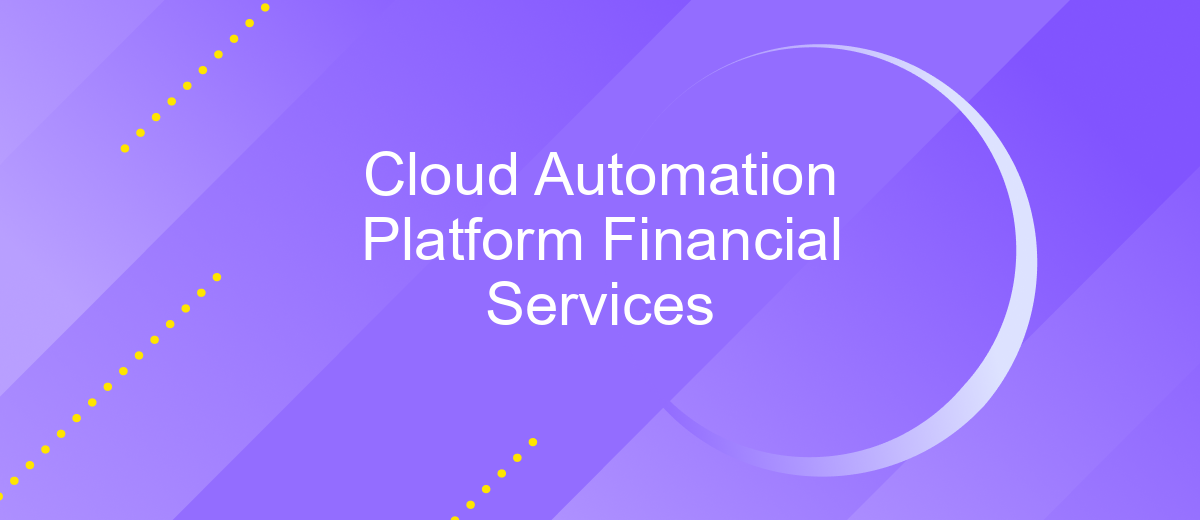Cloud Automation Platform Financial Services
In the rapidly evolving financial services sector, cloud automation platforms are transforming how institutions manage operations, enhance efficiency, and ensure compliance. By leveraging advanced technologies, these platforms streamline workflows, reduce manual errors, and optimize resource allocation. As financial services embrace digital transformation, understanding the role and benefits of cloud automation becomes crucial for staying competitive and meeting the demands of a dynamic market landscape.
Architecture
The architecture of a Cloud Automation Platform for Financial Services is designed to ensure seamless integration, scalability, and security. It leverages cloud-native technologies to automate and optimize financial operations, enhancing efficiency and reducing costs. The platform is built on a microservices architecture, allowing for modular development and easy scalability to accommodate growing business needs.
- Microservices: Each service is independently deployable, facilitating continuous delivery and integration.
- APIs: Secure and robust APIs enable seamless communication between services and external systems.
- Data Management: Centralized data storage ensures consistency, while distributed databases provide high availability.
- Security: Advanced encryption, identity management, and compliance monitoring protect sensitive financial data.
- Orchestration: Automated workflows streamline processes, reducing manual intervention and errors.
This architecture supports real-time analytics and decision-making, empowering financial institutions to respond swiftly to market changes. By utilizing cloud automation, businesses can achieve improved operational efficiency and agility, ensuring they remain competitive in the fast-paced financial landscape. The platform's design prioritizes flexibility and resilience, making it a vital tool for modern financial services.
Benefits

Implementing a Cloud Automation Platform in the financial services sector offers significant advantages. Firstly, it enhances operational efficiency by automating routine tasks, allowing financial institutions to focus on strategic initiatives. Automation reduces the risk of human error, ensuring more accurate data processing and compliance with regulatory requirements. This leads to improved customer satisfaction as services become faster and more reliable. Additionally, cloud-based solutions offer scalability, enabling financial services to adapt quickly to market changes without the need for significant infrastructure investments.
Moreover, integrating various financial services through platforms like ApiX-Drive streamlines workflows and improves collaboration across departments. ApiX-Drive's seamless integration capabilities facilitate the connection of multiple applications, reducing the time and effort needed to manage disparate systems. This integration not only enhances data visibility but also provides real-time insights, empowering decision-makers with the information they need to make informed choices. As a result, financial institutions can innovate and remain competitive in a rapidly evolving market, ultimately driving growth and profitability.
Use Cases

Cloud automation platforms are transforming the financial services industry by enhancing operational efficiency and reducing manual errors. These platforms enable financial institutions to streamline their processes, ensuring faster and more reliable service delivery. By automating routine tasks, firms can focus on strategic activities that drive growth and innovation.
- Regulatory Compliance: Automating compliance checks and reporting helps financial institutions adhere to regulatory requirements more efficiently, reducing the risk of fines and penalties.
- Fraud Detection: Automated systems can analyze large volumes of transactions in real-time, identifying suspicious activities and potential fraud more effectively than manual processes.
- Customer Onboarding: Automation simplifies the onboarding process by verifying customer information and completing necessary documentation quickly, enhancing customer experience.
- Risk Management: Automated risk assessment tools provide timely insights into market and credit risks, enabling better decision-making and risk mitigation strategies.
- Portfolio Management: Automation allows for dynamic portfolio adjustments based on real-time data, optimizing investment performance and aligning with client objectives.
By leveraging cloud automation, financial services can achieve greater agility and scalability. This not only improves customer satisfaction but also positions firms to adapt swiftly to changing market conditions and technological advancements. The integration of automation into financial operations is no longer optional but a strategic necessity for competitive advantage.
How to Get Started

Embarking on the journey of implementing a Cloud Automation Platform in financial services can be transformative. The first step is to thoroughly assess your current infrastructure and identify areas that would benefit most from automation. Understanding your specific needs will help tailor the platform to deliver maximum efficiency and cost-effectiveness.
Next, it's crucial to select a cloud provider that aligns with your operational goals and compliance requirements. Evaluate potential providers based on their security features, scalability, and support services. This ensures that the platform can adapt to your evolving business landscape.
- Conduct a comprehensive needs analysis.
- Choose a compatible cloud provider.
- Develop a detailed implementation plan.
- Train your team on new processes and tools.
- Monitor and refine the platform continuously.
Once you've laid the groundwork, it's time to develop a detailed implementation plan. This should include timelines, resource allocation, and a risk management strategy. Training your team on the new processes and tools is vital for a smooth transition. Finally, establish a system for continuous monitoring and refinement to ensure the platform evolves alongside your business needs.
Best Practices
Implementing cloud automation in financial services requires a strategic approach to ensure efficiency and security. Begin by assessing your current infrastructure to identify areas that can benefit from automation. Prioritize tasks that are repetitive and time-consuming, as these are prime candidates for automation. It's crucial to maintain compliance with financial regulations, so ensure that any automation tools or platforms you use are compliant with industry standards. Regular audits and updates to your automation processes will help maintain security and efficiency.
Integration is key to maximizing the benefits of cloud automation. Utilize services like ApiX-Drive to seamlessly connect different applications and automate data flows between them. This not only saves time but also reduces the risk of human error. Always test integrations in a controlled environment before full deployment to avoid disruptions. Additionally, provide training for your team to ensure they are equipped to manage and optimize these automated processes. By following these best practices, financial services can leverage cloud automation to enhance operational efficiency and improve service delivery.
FAQ
What is a Cloud Automation Platform in Financial Services?
How can Cloud Automation improve operational efficiency in financial services?
What are the security considerations for using a Cloud Automation Platform in Financial Services?
How does integration work with a Cloud Automation Platform?
What are the benefits of using a Cloud Automation Platform for compliance in financial services?
Time is the most valuable resource in today's business realities. By eliminating the routine from work processes, you will get more opportunities to implement the most daring plans and ideas. Choose – you can continue to waste time, money and nerves on inefficient solutions, or you can use ApiX-Drive, automating work processes and achieving results with minimal investment of money, effort and human resources.

